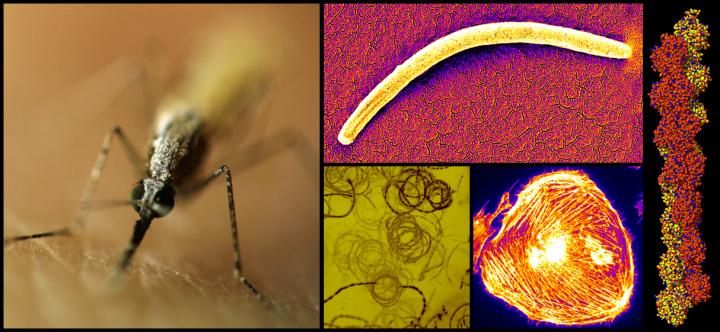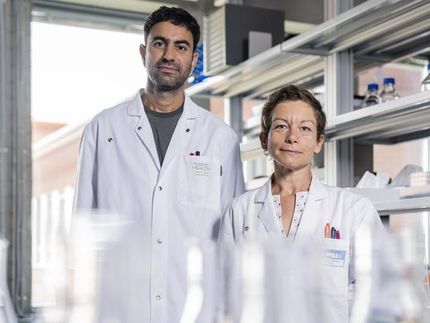Why malaria parasites are faster than human immune cells
Advertisement
malaria parasites of the genus Plasmodium move ten times faster through the skin than immune cells, whose job it is to capture such pathogens. Heidelberg scientists have now found a reason why the parasite is faster than its counterpart. They did this by studying actin, a protein that is important to the structure and movement of cells and that is built differently in parasites and mammals. The findings of Ross Douglas and his colleagues at the Centre for Infectious Diseases (Department of Parasitology) at Heidelberg University Hospital, the Centre for Molecular Biology at the University of Heidelberg (ZMBH), and the Heidelberg Institute for Theoretical Studies (HITS) are not only changing our understanding of a key component of all living cells, but they also provide information that could help in the discovery of new drugs.

Mosquitoes (left) inject malaria parasites (top middle) into skin. The parasites move very rapidly (bottom middle left) using a protein that is very similar to the one our cells (lower middle right) use to construct their form and contract: actin (right). Douglas and co-workers found that certain parts of the parasite protein are responsible for the different behavior of the actin in parasites.
Universitätsklinikum Heidelberg, ZMBH, HITS
How does the malaria parasite move so fast?
Like Lego blocks, which can be put together into long chains, actin is assembled into long rope-like structures called filaments. These filaments are important for the proper functioning of cells - such as muscle cells - and enable each of our movements. However, they also serve to enable immune system cells to move and capture invading pathogens. Likewise, they are of great importance for the movement of the malaria parasite. "Strangely enough, malaria parasites are ten times nimbler than the fastest of our immune cells and literally outrun our immune defences. If we understand this important difference in movement, we can target and stop the parasite," says Dr. Ross Douglas from the Heidelberg Centre for Infectious Diseases. A key issue is how the rate at which actin filaments are formed and broken down differs between parasites and mammals.
Mammal-parasite protein hybrids lead to new insights
It was known that certain sections of the actin protein differ between the parasite and mammals. To investigate the reasons behind the difference in speed, scientists replaced parts of the parasite protein with corresponding sections of protein from mammalian actin in the laboratory. "When we made these changes in the parasite, we noticed that some parasites could not survive at all and others suddenly hesitated when they moved," says Dr. Ross Douglas. To investigate the underlying mechanism, the participating scientists performed experiments and computer simulations ranging from modeling at the molecular level to observing the parasites in live animals. "High-performance computers were required for simulations to observe how the structure and dynamics of actin filaments change when individual sections are swapped," says Prof. Rebecca Wade, who heads research groups at the Heidelberg Institute for Theoretical Studies (HITS) and at the Centre for Molecular Biology (ZMBH) at Heidelberg University that investigate protein interactions via computer simulations and mathematical modelling.
These findings could now be used to discover chemical compounds that selectively target parasite actin and affect either the building or breakdown of the filament. "In this way, it could be possible to effectively stop the entire parasite," Dr. Ross Douglas summarizes. An example for this approach is tubulin, another type of protein which is involved in the building of the cytoskeleton via so-called microtubules. Medicines that target parasite microtubules - such as mebendazole - have been successfully used for decades to treat humans and animals for parasitic worms. This joint research project was partially funded by the innovation fund FRONTIER at Heidelberg University.
Original publication
Ross G. Douglas, Prajwal Nandekar, Julia-Elisabeth Aktories, Hirdesh Kumar, Rebekka Weber, Julia M. Sattler, Mirko Singer, Simone Lepper, S. Kashif Sadiq, Rebecca C. Wade, Friedrich Frischknecht; "Inter-subunit interactions drive divergent dynamics in mammalian and Plasmodium actin filaments"; PLOS Biology; 2018

























































